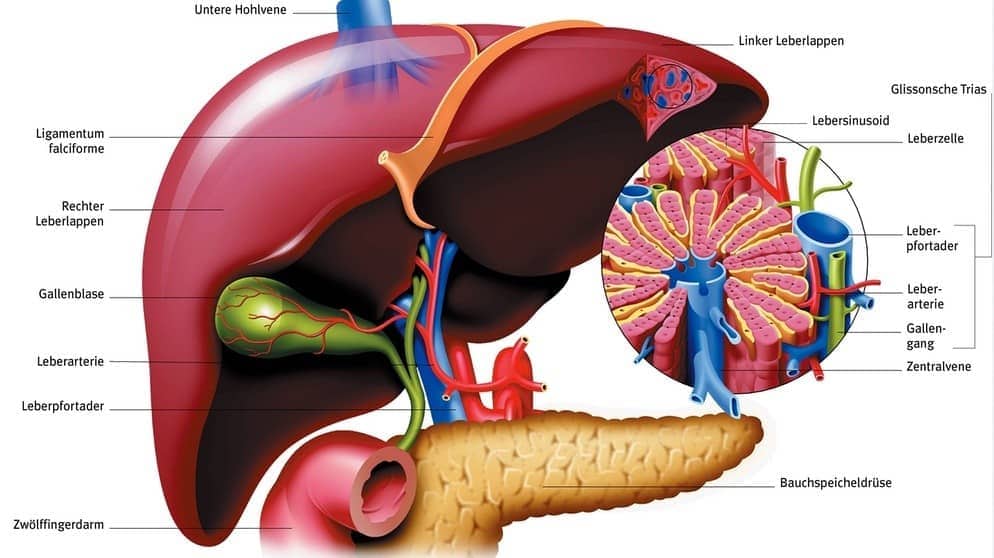Cholesterol is a fat-like substance that is made in the liver. It is an important basic substance that is found in all cells in the human body. The body can cover all of its cholesterol requirements by itself (around 1 to 1.5 g per day), so that no additional cholesterol has to be taken in with food. Cholesterol does the following:
- It is generally involved in the structure of the cell wall.
- It forms the framework for the steroid hormones, e.g. sex hormones.
- It forms the basic substance of bile acid.
- It activates and transports vitamin D.
Importance to health
Whether or not an increased cholesterol level in the blood is a health hazard is a constant and heated debate. At least since Prof. Dr. med. Walter Hartenbach, we know that the pharmaceutical companies have their fingers in the game here too – and cholesterol is even important for our health.
Occurrence
- Animal: Sausage, meat, eggs, butter, cream, fatty cheese and mayonnaise, offal and shellfish contain a lot of food cholesterol.
- Vegetable: Cholesterol is negligible in plant-based foods.
Classification
The average cholesterol value for adults worldwide is 250 mg / dl. Values up to 350 mg / dL are common and normal. Since the steroid hormone cortisol formed from cholesterol is the essential activator for ensuring the energetic potential of glucose, the respective production of cholesterol is subject to large fluctuations. The liver, the production facility for cholesterol, regulates the need, and it is dangerous to try to lower the cholesterol level and irresponsible to ask for it to be below 200 mg / dl.
There is the bad business of the margarine industry and the cholesterol-lowering drugs of the manufacturing pharmaceutical industry. Lowering cholesterol is associated with a serious decrease in mental and physical performance and an increase in cancerous degenerations.
Cholesterol has nothing to do with the development of arteriosclerosis or a heart attack. In the arteriosclerotic wall thickening of the vessels, which consist of cells and connective tissue, a maximum of one percent cholesterol deposits can be found.
There are no different cholesterols and it is absurd to talk about good and bad cholesterol. There are only two protein transport bodies for cholesterol (lipoproteins): first, the less required HDL lipoprotein for transporting the cholesterol ingested with food and the free cholesterol to the liver – mainly for the formation of bile acids – and second, the LDL lipoprotein with the Task of delivering the cholesterol produced by the liver (that’s over 80 percent of cholesterol) to the trillions of human cells every day so that they can grow and carry out their functions.
The LDL-lipoprotein-cholesterol complex, wrongly called LDL-cholesterol, is necessary for the function of all cells, for the development of the steroid hormones which regulate almost the entire metabolism and thus for the maintenance of our life. Therefore, all cells have a receptor for the LDL lipoprotein. Since the LDL-lipoprotein-cholesterol complex has an exclusively useful function, has no influence on the development of arteriosclerosis and is subject to natural fluctuations, it makes no sense to speak of pathological hypercholesterolemia, which unfortunately has seduced a large number of doctors into such Take nonsense uncritically.
Basics
Cholesterol is the basic substance for the steroid hormone cortisol, which must be regarded as the most important stress hormone. Its essential importance lies in the activation of the energetic substances glucose and the mineral potassium, which control all of our mental and physical activities. Cortisol is also an effective antiallergic agent and is particularly useful for combating shock; it increases blood coagulation by increasing the number of blood platelets and is therefore very suitable for stopping bleeding, for example in the case of bleeding or after an overdose of anti-coagulant drugs. Finally, it stabilizes the cardiovascular function, increases blood pressure and stimulates euphoria, and slows down excessive cell growth, also known as cancer.
Cholesterol cannot be transported in the blood because as a lipid (fat body) it is insoluble in water. It can only be transported if it binds to a special protein body, a protein.
Cholesterol is bound by the HDL protein and the LDL protein. The HDL lipoprotein absorbs the cholesterol supplied from food as well as the cholesterol rejected by the cells. To what extent cholesterol deposits in the organs and in the vessels (only a maximum of one percent in the plaques) can be absorbed by the HDL lipoprotein is unclear, and the statements in this regard are so far without any scientific basis. The cholesterol-laden HDL lipoprotein migrates to the liver and is broken down by the liver, mainly to form bile acids (over 80 percent) and to re-synthesize HDL protein and cholesterol. The LDL lipoprotein, which develops from the VLDL lipoprotein formed in the liver, absorbs the cholesterol produced by the liver (over 80 percent) in order to deliver it to the quadrillion cells of the human organism.
All cells have a specific receptor for LDL lipoprotein, which means that they are able to take up the LDL lipoprotein with its load of cholesterol and transport it into the interior of the cell. Inside the cell, the cholesterol is released, which is urgently required for the mitochondria and thus for the growth and functions of the cells. Furthermore, the cholesterol is required for the cell walls, on the one hand to seal them, on the other hand to ensure the multiple functions of the cell walls. The LDL-lipoprotein-cholesterol complex, wrongly called LDL-cholesterol, ensures the safeguarding of all organ functions, the stabilization of the orderly cell growth and, with great probability, but not proven, for the prevention of cancerous degeneration.
The inadequate explanation of the meaning of the HOL and the LDL protein, which is also deliberately not given, has led to the idea that two different cholesterols are present.
Just as there is no bad cholesterol, there is no bad cancer either. There is no such thing as bad and good cancer. There is only one cancer, which is actually a cell proliferation.
Unfortunately, this misleading opinion is also spread by many “health centers” whose scientific knowledge shows serious gaps, not only in this area, and questions their justification to act as specialist institutions. It can be seen here, too, that most of them are just phonographs. The margarine industry and the pharmaceutical industry, which produces cholesterol-lowering drugs, have succeeded in portraying the important LDL-cholesterol complex as “bad” cholesterol and misleading the population worldwide.
In addition to the astonishing lack of knowledge, business-oriented thinking plays a certain role here, because with the false assertion that every adult with a cholesterol level above 200 mg / dl is to be regarded as sick and in need of treatment, practically the entire adult population of the world is described as sick and in need of treatment and declared permanent patients. It should therefore be emphasized once again that almost the entire adult population (80–90 percent) has an average cholesterol value of 250 mg / dl and values of up to 350 mg / dl speak for considerable vitality and can therefore be assessed positively.
Blood levels of cholesterol
The total level of cholesterol, consisting of the LDL complex and the HOL complex, is measured in the blood. The proportion of the LDL complex compared to the HOL complex is about 75 to 25 percent. The total value of cholesterol for adults is on average around 250 mg / dl worldwide, with greater physical exertion due to the associated increased production of the cholesterol-dependent stress hormone cortisol higher, around 300 to 350 mg / dl, sometimes up to just under 400 mg / dl. To put the normal value at 200 mg / dl and below, as the enterprising industry does, means that almost the entire adult population is described as sick and in need of treatment. It is unbelievable that such inhuman nonsense is accepted without criticism by such a large number of doctors.
The following cholesterol levels were found in the German population:
Table 5: Age-dependent cholesterol levels
| The cholesterol level
is also age dependent | Age | Average | upper limit |
| 10-19 | 175 mg / dl | 230 mg / dl | |
| 25-29 | 198 mg / dl | 270 mg / dl | |
| 40-59 | 250 mg / dl | 350 mg / dl | |
| 65-85 | slightly decreasing | 330 mg / dl |
The word “control indication” is intended to indicate the need to investigate the cause of high cholesterol levels. Regarding cholesterol determinations, it is unfortunately overlooked without exception that the cholesterol level is subject to strong fluctuations.
You can have a fondue, raclette or a greasy burger in one evening, your cholesterol level will rise.
The body produces cholesterol itself – mainly in the liver, adrenal gland, ovaries and cells of the small intestine. Normally about two-thirds of the cholesterol is produced by the body itself, and one-third comes from food.
The body needs cholesterol in many places
Cholesterol is needed for the formation of bile acid, hormones – such as cortisone and the sex hormone estrogen – as well as the construction of cell walls. So it is an indispensable building block in the body. So that it is available even in times of food shortages, there is the body’s own production. There is a sophisticated system of rules between the exogenous and endogenous intake of cholesterol: if we eat little cholesterol, the body produces more itself. If we eat a lot of cholesterol, our own production is reduced.
The networking of the brain cells only works when the cholesterol level in the blood is high enough. Ergo: less cholesterol, more stupid consumers. Lowering cholesterol is pointless, if not dangerous, in healthy people. But: Long live the fraud. With fake studies. With unsustainable numbers and a preventive strategy. Why do people keep telling each other that cholesterol is dangerous? Because a large part of the population are phonographers. Robotic brains that just parrot everything they are told.
Question:
Why do you say that the goal of the pharmaceutical and food industry is to breed a maximum of chronically ill people? I can understand that about the pharmaceutical industry, but why do you put the food industry on the same criminal level as the pharmaceutical industry?
Answer:
Sick people have a sick consciousness, that’s why they are sick. Healthy people have a healthy consciousness, that’s exactly why they are healthy. A sick consciousness selects unhealthy, harmful food for its body. So the food industry wants sick people to consume until they burst. The food industry cannot serve healthy people with a healthy consciousness – they are simply not its target group. The pharmaceutical industry then takes over these sick people and calls them patients. A patient (from Latin patiens, German “patient”, “enduring”, “enduring”, “enduring”, “suffering”) is someone who uses medical services or the services of other people who perform treatment.
The anti-cholesterol campaign – a dangerous misdirection
The misleading media:
The press, television and radio are obviously in the clutches of the “anti-cholesterol mafia” in their reports on cholesterol, which is largely controlled by the margarine and cholesterol-lowering pharmaceutical industries. In their broadcasts and reports, without exception, only the medical professionals mentioned, who are supported by the industry, are mentioned and the appearance of expert scientists is prevented by all means and with an unrivaled audacity.
- Cholesterol has no effect on atherosclerosis and heart attacks
- All scientific publications warn against cholesterol-lowering drugs
- Negative effects of the cholesterol reduction are concealed
- Cholesterol-lowering drugs increase the risk of heart attacks and cancer
- The pharmaceutical industry is bending the statistics
- High cholesterol – lower cancer risk
- Most doctors lack knowledge of cholesterol metabolism
- The Lipobay (R) scandal was quickly forgotten
- The puppet media continues to spread misinformation from the industry
- Scientific studies are sponsored by the pharmaceutical industry
- Cholesterol is NOT to blame for coronary artery disease
- The pharmaceutical industry and its employees, the doctors, look forward to long-term patients
- If the cholesterol level drops – performance decreases rapidly
- There is no such thing as good or bad cholesterol
- Atherosclerosis and plaques consist of no more than one percent cholesterol
- As the cholesterol level is lowered, the risk of cancer increases
The pharmaceutical and food industries live neither on the healthy nor on the dead …
The goal of the pharmaceutical and food industries is to make as many chronically ill people as possible and as much profit as possible!







